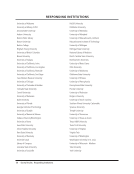138 · Representative Documents: Collection/Selection Policies
UNIVERSITY OF ALABAMA
Selection Policies and Procedures
http://www.lib.ua.edu/wiki/digcoll/index.php/Selection_Policies_and_Procedures
Selection Policies and Procedures -UA Libraries Digital Services Planning and Documentation
http://www.lib.ua.edu/wiki/digcoll/index.php/Selection_Policies_and_Procedures[8/7/13 7:00:28 PM]
4. Are there complementary collections in other institutions? Would one of these institutions be
interested in partnering?
Formats/Languages/Nature of the Materials
Some formats are more established for digitization and online delivery than others. Currently, we have
the equipment necessary to digitize:
1. unbound documents (such as letters) and photos
2. unbound books in good condition, if not oversized
3. bound books dependent upon condition, looseness of binding, margins and size
4. fragile documents, dependent upon archivist recommendations
5. slides and glass plate negatives
6. artifacts, dependent upon size and
7. cassette and reel-to-reel (1/4 inch) audio tapes.
We do not currently support the online storage and delivery of video.
Special formats such as newspapers represent another type of material that would require special
systems to store and deliver.
Foreign-language materials require project staff who are proficient in the language(s), which may add to
the difficulty of assembling the project team. This factor may also add to the expense of the project and
the timeline.
Creation of searchable text requires additional time and skills non-Western languages present
challenges. Searchable text in a foreign language requires the user to enter text in this language. In
general, the decision to provide searchable text, either corrected or uncorrected, adds considerable
expense to a text project and should be evaluated using the other factors noted above.
Another factor related to the format is the condition of the materials. Digitization may serve either a
preservation or access need, but most projects address both issues. Digitization may protect fragile
items by reducing handling of the originals. However, these materials must be able to withstand the
handling necessary for digitization. If the determination has been made that the items can withstand
digitization, the condition of the material will also be a factor in deciding whether to outsource
digitization or perform the work in-house.
Sources of Funding
Digitization projects are funded with internal university funds and external grant funds. Oftentimes, the
funding agency stipulates priorities for funding. The goal is to match a high-priority project with the
appropriate funding source. Other funding opportunities may present more difficult challenges, such as
requiring a large number of partners or a specific type of partner or specifying very short deadlines for
completion of the work, without the possibility of an extension.
The best approach with regard to grant funding is to develop skeletal outlines for digitization projects for
a number of important collections and then research potential funding sources. Once a good match has
been found, the details of project planning can be finalized, bringing the project in line with funding
requirements and evaluative criteria as closely as possible.
Selection references: [[1] ]
UNIVERSITY OF ALABAMA
Selection Policies and Procedures
http://www.lib.ua.edu/wiki/digcoll/index.php/Selection_Policies_and_Procedures
Selection Policies and Procedures -UA Libraries Digital Services Planning and Documentation
http://www.lib.ua.edu/wiki/digcoll/index.php/Selection_Policies_and_Procedures[8/7/13 7:00:28 PM]
4. Are there complementary collections in other institutions? Would one of these institutions be
interested in partnering?
Formats/Languages/Nature of the Materials
Some formats are more established for digitization and online delivery than others. Currently, we have
the equipment necessary to digitize:
1. unbound documents (such as letters) and photos
2. unbound books in good condition, if not oversized
3. bound books dependent upon condition, looseness of binding, margins and size
4. fragile documents, dependent upon archivist recommendations
5. slides and glass plate negatives
6. artifacts, dependent upon size and
7. cassette and reel-to-reel (1/4 inch) audio tapes.
We do not currently support the online storage and delivery of video.
Special formats such as newspapers represent another type of material that would require special
systems to store and deliver.
Foreign-language materials require project staff who are proficient in the language(s), which may add to
the difficulty of assembling the project team. This factor may also add to the expense of the project and
the timeline.
Creation of searchable text requires additional time and skills non-Western languages present
challenges. Searchable text in a foreign language requires the user to enter text in this language. In
general, the decision to provide searchable text, either corrected or uncorrected, adds considerable
expense to a text project and should be evaluated using the other factors noted above.
Another factor related to the format is the condition of the materials. Digitization may serve either a
preservation or access need, but most projects address both issues. Digitization may protect fragile
items by reducing handling of the originals. However, these materials must be able to withstand the
handling necessary for digitization. If the determination has been made that the items can withstand
digitization, the condition of the material will also be a factor in deciding whether to outsource
digitization or perform the work in-house.
Sources of Funding
Digitization projects are funded with internal university funds and external grant funds. Oftentimes, the
funding agency stipulates priorities for funding. The goal is to match a high-priority project with the
appropriate funding source. Other funding opportunities may present more difficult challenges, such as
requiring a large number of partners or a specific type of partner or specifying very short deadlines for
completion of the work, without the possibility of an extension.
The best approach with regard to grant funding is to develop skeletal outlines for digitization projects for
a number of important collections and then research potential funding sources. Once a good match has
been found, the details of project planning can be finalized, bringing the project in line with funding
requirements and evaluative criteria as closely as possible.
Selection references: [[1] ]


































































































































































































